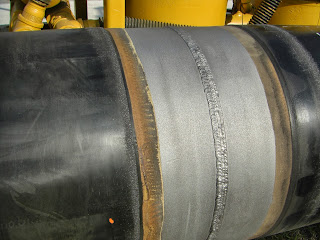Can WPC100M be used with a three layer coating?
(as asked here)
Short Answer: YES (thank you for the question Mr. Aizat)
Longer Answer: WPC100M is fully compatible with a three layer coating (I am assuming here that what you mean by a "three coat system" is a factory applied coating which includes a layer of epoxy (most often FBE) followed by a layer of adhesive and ending with an outer layer of a polyethylene.
The mastic sealant of the WPC100M is designed to bond to polyethylene. As evidence: When you receive a WPC100M shrink sleeve out of the box; well, the mastic sealant has already bonded to a PE (the sleeve backing itself!). In addition, the mastic is designed to wrap around the pipeline and bond to the the backing of the WPC100M sleeve (as the 'cigarette wrap is formed)! The simple fact is the WPC100M mastic sealant is an aggressive mastic designed to bond well to all commonly used factory applied pipeline coatings (and has a long use history).
That being said, ultimately whether a field joint coating is approved or not is decided by the owner of the pipeline (or the engineer who they've hired to write their specifications). In my opinion; proven out by my experience; the WPC100M would be an excellent field joint coating for a three layer polyethylene coated pipe (TLPE). It would work well there - and has worked in hundreds of thousands of other cases - and it would provide excellent long term protection of that field join just as the data sheet indicates it would.
BUT - in some cases, a pipeline owner company has selected a three layer factory applied coating (and paid the significant expense to get a three layer factory applied coating) for a very specific reason. They have selected that coating because they want a pipeline coating that offers the BEST of all worlds. They want all of the strengths of an epoxy coating (CD resistance, high shear values) AND all of the strengths of a PE coating (abrasion resistance, electrical resistivity, penetration resistance, peel values).
In those cases, it is possible that the specification will require a similar coating system on the field joint. This could be accomplished in a number of ways and would include simply using the Raychem S1301M epoxy as the initial field joint coating; with a WPC100M shrink sleeve installed over the top of it. This would essentially recreate that three layer coating on the field joint. Other options could be our HTLP coating systems (which also utilize the S1301M epoxy underneath an HTLP60 or HTLP80 shrink sleeve - again - recreating a three layer coating system on the field joint).
In cases where a pipeline is being installed offshore, and liquid epoxies (due to cure time / etc) are not really conducive. I've seen many, many cases where a WPC100M shrink sleeve was installed as the field joint coating on three layer coated pipeline with outstanding results.
All of that to say - YES - WPC100M can be used with three layer coated pipe (and it has been done often) - but I cannot speak to any specific pipeline project without seeing the specification for the pipeline project myself!
Thank you for the question!


















